Barnet Hospital: Operations, Logistics, and Supply Chain Challenges
VerifiedAdded on 2021/02/21
|13
|3875
|254
Report
AI Summary
This report provides an in-depth analysis of the key operational, logistical, and supply chain management issues faced by Barnet Hospital, a district general hospital in North London. The report explores challenges in managing people, including communication gaps among departments and lack of leadership, which impact patient satisfaction and care quality. It also examines the challenges faced by the logistics manager, such as customer service, stakeholder conflicts, and lack of coordination. Furthermore, the report investigates the functions and operations that support the hospital's market, focusing on the healthcare delivery system, including the patient, care team, organization, and economic/political environment. The report highlights the importance of adequate infrastructure and ethical practices in delivering quality services. The report also offers recommendations for improving operations and supply chain management within the hospital to enhance patient care and operational efficiency.

BARNET
HOSPITAL
HOSPITAL
Paraphrase This Document
Need a fresh take? Get an instant paraphrase of this document with our AI Paraphraser
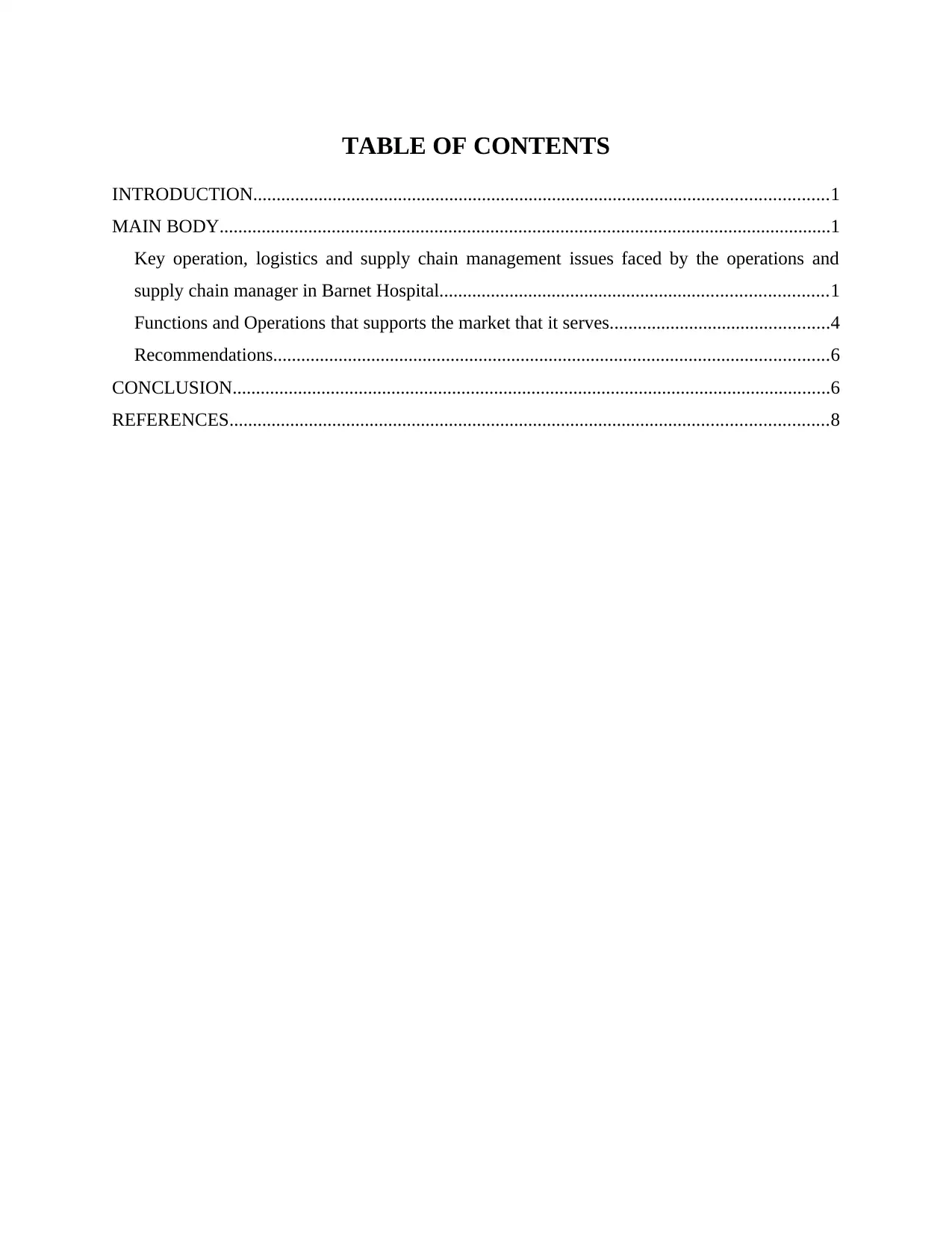
TABLE OF CONTENTS
INTRODUCTION...........................................................................................................................1
MAIN BODY...................................................................................................................................1
Key operation, logistics and supply chain management issues faced by the operations and
supply chain manager in Barnet Hospital...................................................................................1
Functions and Operations that supports the market that it serves...............................................4
Recommendations.......................................................................................................................6
CONCLUSION................................................................................................................................6
REFERENCES................................................................................................................................8
INTRODUCTION...........................................................................................................................1
MAIN BODY...................................................................................................................................1
Key operation, logistics and supply chain management issues faced by the operations and
supply chain manager in Barnet Hospital...................................................................................1
Functions and Operations that supports the market that it serves...............................................4
Recommendations.......................................................................................................................6
CONCLUSION................................................................................................................................6
REFERENCES................................................................................................................................8

INTRODUCTION
Logistic, operations and supply chain management are similar but having different roles.
Supply chain management encompasses the planning and management of all the activities
involves in sourcing and procurement, conversion and all the activities of logistic management.
Further it also includes cooperation and coordination with channel partners that can be suppliers,
intermediaries, customers and may be third part service providers (Moons, Waeyenbergh, and
Pintelon, 2019). In services industry, it is not easy to manage people, supply chain management
is tends to be very critical as it can able to get customers closer to the firm.
In this present report, Barnet Hospital is being chosen for assessment. It is a district
general hospital which is situated in Barnet, in north London founded in 1920. This essay will
present the key operation, logistic and supply chain management issues faced by hospital. The
two areas selected are managing people in operations ad supply chain and Logistic Mix.
MAIN BODY
Key operation, logistics and supply chain management issues faced by the operations and supply
chain manager in Barnet Hospital.
According to the Zepeda, Nyaga and Young, (2016) Operation, logistic and supply chain
management are one of the most important part of the organisation as without this it is not
possible run the organisation smoothly. Supply chain management is very broad category as it
covers many areas in both services and manufacturing industries which includes including the
functions of sourcing, materials management, operation's planning, distribution, logistic, retail,
forecasting of demands, fulfilment of orders etc. However, Benzidia and et.al., (2019) said that,
logistic is the key area of supply chain management as it helps in organising and managing the
storage inventory in the hospital. The logistic manager of Barnet hospital is the very important as
they used to organises the storage as well as distribution of goods and services in order to make
the customers satisfied. Logistic operations helps to interacts as well as interfaces with the whole
hospital along with the external firms, vendors, suppliers, customers, carriers and more. As per
the Gardner, Linderman and McFadden, (2018) the management of logistic of Barnet hospital is
accurate and effective as they successfully provide the right services and products in right places
at tight time with right quality.
Challenges faced by Logistic Manager in Barnet Hospital
1
Logistic, operations and supply chain management are similar but having different roles.
Supply chain management encompasses the planning and management of all the activities
involves in sourcing and procurement, conversion and all the activities of logistic management.
Further it also includes cooperation and coordination with channel partners that can be suppliers,
intermediaries, customers and may be third part service providers (Moons, Waeyenbergh, and
Pintelon, 2019). In services industry, it is not easy to manage people, supply chain management
is tends to be very critical as it can able to get customers closer to the firm.
In this present report, Barnet Hospital is being chosen for assessment. It is a district
general hospital which is situated in Barnet, in north London founded in 1920. This essay will
present the key operation, logistic and supply chain management issues faced by hospital. The
two areas selected are managing people in operations ad supply chain and Logistic Mix.
MAIN BODY
Key operation, logistics and supply chain management issues faced by the operations and supply
chain manager in Barnet Hospital.
According to the Zepeda, Nyaga and Young, (2016) Operation, logistic and supply chain
management are one of the most important part of the organisation as without this it is not
possible run the organisation smoothly. Supply chain management is very broad category as it
covers many areas in both services and manufacturing industries which includes including the
functions of sourcing, materials management, operation's planning, distribution, logistic, retail,
forecasting of demands, fulfilment of orders etc. However, Benzidia and et.al., (2019) said that,
logistic is the key area of supply chain management as it helps in organising and managing the
storage inventory in the hospital. The logistic manager of Barnet hospital is the very important as
they used to organises the storage as well as distribution of goods and services in order to make
the customers satisfied. Logistic operations helps to interacts as well as interfaces with the whole
hospital along with the external firms, vendors, suppliers, customers, carriers and more. As per
the Gardner, Linderman and McFadden, (2018) the management of logistic of Barnet hospital is
accurate and effective as they successfully provide the right services and products in right places
at tight time with right quality.
Challenges faced by Logistic Manager in Barnet Hospital
1
⊘ This is a preview!⊘
Do you want full access?
Subscribe today to unlock all pages.

Trusted by 1+ million students worldwide
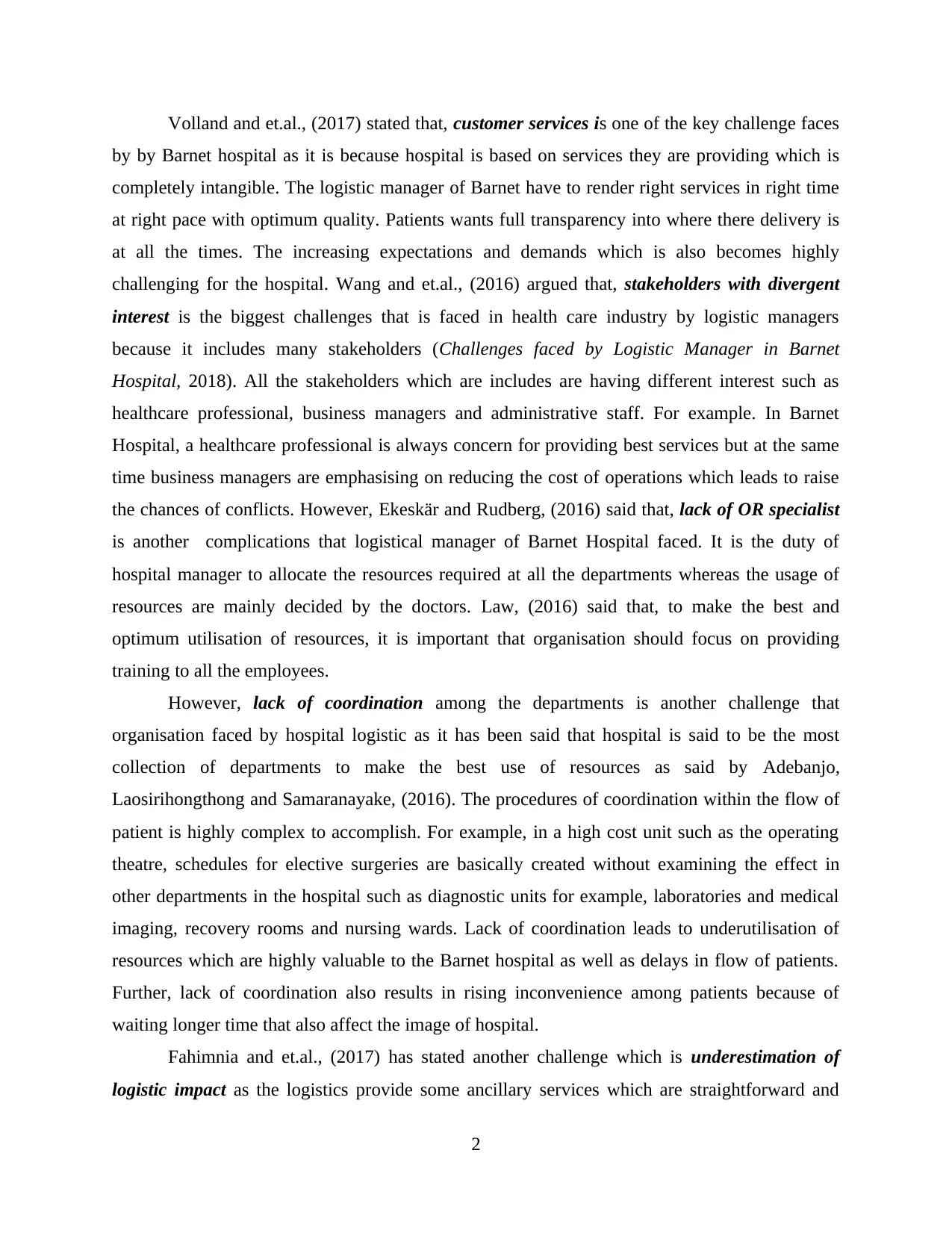
Volland and et.al., (2017) stated that, customer services is one of the key challenge faces
by by Barnet hospital as it is because hospital is based on services they are providing which is
completely intangible. The logistic manager of Barnet have to render right services in right time
at right pace with optimum quality. Patients wants full transparency into where there delivery is
at all the times. The increasing expectations and demands which is also becomes highly
challenging for the hospital. Wang and et.al., (2016) argued that, stakeholders with divergent
interest is the biggest challenges that is faced in health care industry by logistic managers
because it includes many stakeholders (Challenges faced by Logistic Manager in Barnet
Hospital, 2018). All the stakeholders which are includes are having different interest such as
healthcare professional, business managers and administrative staff. For example. In Barnet
Hospital, a healthcare professional is always concern for providing best services but at the same
time business managers are emphasising on reducing the cost of operations which leads to raise
the chances of conflicts. However, Ekeskär and Rudberg, (2016) said that, lack of OR specialist
is another complications that logistical manager of Barnet Hospital faced. It is the duty of
hospital manager to allocate the resources required at all the departments whereas the usage of
resources are mainly decided by the doctors. Law, (2016) said that, to make the best and
optimum utilisation of resources, it is important that organisation should focus on providing
training to all the employees.
However, lack of coordination among the departments is another challenge that
organisation faced by hospital logistic as it has been said that hospital is said to be the most
collection of departments to make the best use of resources as said by Adebanjo,
Laosirihongthong and Samaranayake, (2016). The procedures of coordination within the flow of
patient is highly complex to accomplish. For example, in a high cost unit such as the operating
theatre, schedules for elective surgeries are basically created without examining the effect in
other departments in the hospital such as diagnostic units for example, laboratories and medical
imaging, recovery rooms and nursing wards. Lack of coordination leads to underutilisation of
resources which are highly valuable to the Barnet hospital as well as delays in flow of patients.
Further, lack of coordination also results in rising inconvenience among patients because of
waiting longer time that also affect the image of hospital.
Fahimnia and et.al., (2017) has stated another challenge which is underestimation of
logistic impact as the logistics provide some ancillary services which are straightforward and
2
by by Barnet hospital as it is because hospital is based on services they are providing which is
completely intangible. The logistic manager of Barnet have to render right services in right time
at right pace with optimum quality. Patients wants full transparency into where there delivery is
at all the times. The increasing expectations and demands which is also becomes highly
challenging for the hospital. Wang and et.al., (2016) argued that, stakeholders with divergent
interest is the biggest challenges that is faced in health care industry by logistic managers
because it includes many stakeholders (Challenges faced by Logistic Manager in Barnet
Hospital, 2018). All the stakeholders which are includes are having different interest such as
healthcare professional, business managers and administrative staff. For example. In Barnet
Hospital, a healthcare professional is always concern for providing best services but at the same
time business managers are emphasising on reducing the cost of operations which leads to raise
the chances of conflicts. However, Ekeskär and Rudberg, (2016) said that, lack of OR specialist
is another complications that logistical manager of Barnet Hospital faced. It is the duty of
hospital manager to allocate the resources required at all the departments whereas the usage of
resources are mainly decided by the doctors. Law, (2016) said that, to make the best and
optimum utilisation of resources, it is important that organisation should focus on providing
training to all the employees.
However, lack of coordination among the departments is another challenge that
organisation faced by hospital logistic as it has been said that hospital is said to be the most
collection of departments to make the best use of resources as said by Adebanjo,
Laosirihongthong and Samaranayake, (2016). The procedures of coordination within the flow of
patient is highly complex to accomplish. For example, in a high cost unit such as the operating
theatre, schedules for elective surgeries are basically created without examining the effect in
other departments in the hospital such as diagnostic units for example, laboratories and medical
imaging, recovery rooms and nursing wards. Lack of coordination leads to underutilisation of
resources which are highly valuable to the Barnet hospital as well as delays in flow of patients.
Further, lack of coordination also results in rising inconvenience among patients because of
waiting longer time that also affect the image of hospital.
Fahimnia and et.al., (2017) has stated another challenge which is underestimation of
logistic impact as the logistics provide some ancillary services which are straightforward and
2
Paraphrase This Document
Need a fresh take? Get an instant paraphrase of this document with our AI Paraphraser
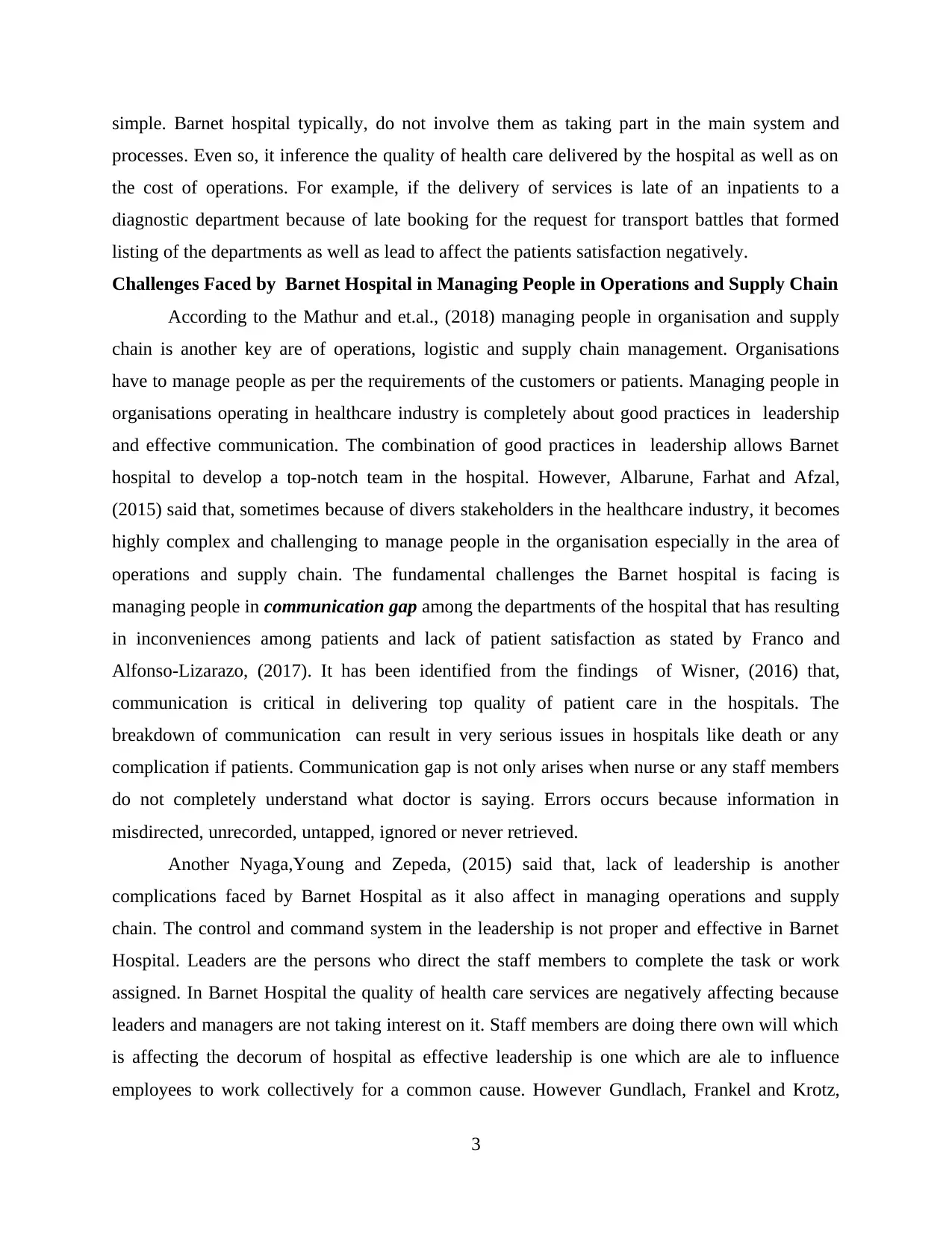
simple. Barnet hospital typically, do not involve them as taking part in the main system and
processes. Even so, it inference the quality of health care delivered by the hospital as well as on
the cost of operations. For example, if the delivery of services is late of an inpatients to a
diagnostic department because of late booking for the request for transport battles that formed
listing of the departments as well as lead to affect the patients satisfaction negatively.
Challenges Faced by Barnet Hospital in Managing People in Operations and Supply Chain
According to the Mathur and et.al., (2018) managing people in organisation and supply
chain is another key are of operations, logistic and supply chain management. Organisations
have to manage people as per the requirements of the customers or patients. Managing people in
organisations operating in healthcare industry is completely about good practices in leadership
and effective communication. The combination of good practices in leadership allows Barnet
hospital to develop a top-notch team in the hospital. However, Albarune, Farhat and Afzal,
(2015) said that, sometimes because of divers stakeholders in the healthcare industry, it becomes
highly complex and challenging to manage people in the organisation especially in the area of
operations and supply chain. The fundamental challenges the Barnet hospital is facing is
managing people in communication gap among the departments of the hospital that has resulting
in inconveniences among patients and lack of patient satisfaction as stated by Franco and
Alfonso-Lizarazo, (2017). It has been identified from the findings of Wisner, (2016) that,
communication is critical in delivering top quality of patient care in the hospitals. The
breakdown of communication can result in very serious issues in hospitals like death or any
complication if patients. Communication gap is not only arises when nurse or any staff members
do not completely understand what doctor is saying. Errors occurs because information in
misdirected, unrecorded, untapped, ignored or never retrieved.
Another Nyaga,Young and Zepeda, (2015) said that, lack of leadership is another
complications faced by Barnet Hospital as it also affect in managing operations and supply
chain. The control and command system in the leadership is not proper and effective in Barnet
Hospital. Leaders are the persons who direct the staff members to complete the task or work
assigned. In Barnet Hospital the quality of health care services are negatively affecting because
leaders and managers are not taking interest on it. Staff members are doing there own will which
is affecting the decorum of hospital as effective leadership is one which are ale to influence
employees to work collectively for a common cause. However Gundlach, Frankel and Krotz,
3
processes. Even so, it inference the quality of health care delivered by the hospital as well as on
the cost of operations. For example, if the delivery of services is late of an inpatients to a
diagnostic department because of late booking for the request for transport battles that formed
listing of the departments as well as lead to affect the patients satisfaction negatively.
Challenges Faced by Barnet Hospital in Managing People in Operations and Supply Chain
According to the Mathur and et.al., (2018) managing people in organisation and supply
chain is another key are of operations, logistic and supply chain management. Organisations
have to manage people as per the requirements of the customers or patients. Managing people in
organisations operating in healthcare industry is completely about good practices in leadership
and effective communication. The combination of good practices in leadership allows Barnet
hospital to develop a top-notch team in the hospital. However, Albarune, Farhat and Afzal,
(2015) said that, sometimes because of divers stakeholders in the healthcare industry, it becomes
highly complex and challenging to manage people in the organisation especially in the area of
operations and supply chain. The fundamental challenges the Barnet hospital is facing is
managing people in communication gap among the departments of the hospital that has resulting
in inconveniences among patients and lack of patient satisfaction as stated by Franco and
Alfonso-Lizarazo, (2017). It has been identified from the findings of Wisner, (2016) that,
communication is critical in delivering top quality of patient care in the hospitals. The
breakdown of communication can result in very serious issues in hospitals like death or any
complication if patients. Communication gap is not only arises when nurse or any staff members
do not completely understand what doctor is saying. Errors occurs because information in
misdirected, unrecorded, untapped, ignored or never retrieved.
Another Nyaga,Young and Zepeda, (2015) said that, lack of leadership is another
complications faced by Barnet Hospital as it also affect in managing operations and supply
chain. The control and command system in the leadership is not proper and effective in Barnet
Hospital. Leaders are the persons who direct the staff members to complete the task or work
assigned. In Barnet Hospital the quality of health care services are negatively affecting because
leaders and managers are not taking interest on it. Staff members are doing there own will which
is affecting the decorum of hospital as effective leadership is one which are ale to influence
employees to work collectively for a common cause. However Gundlach, Frankel and Krotz,
3
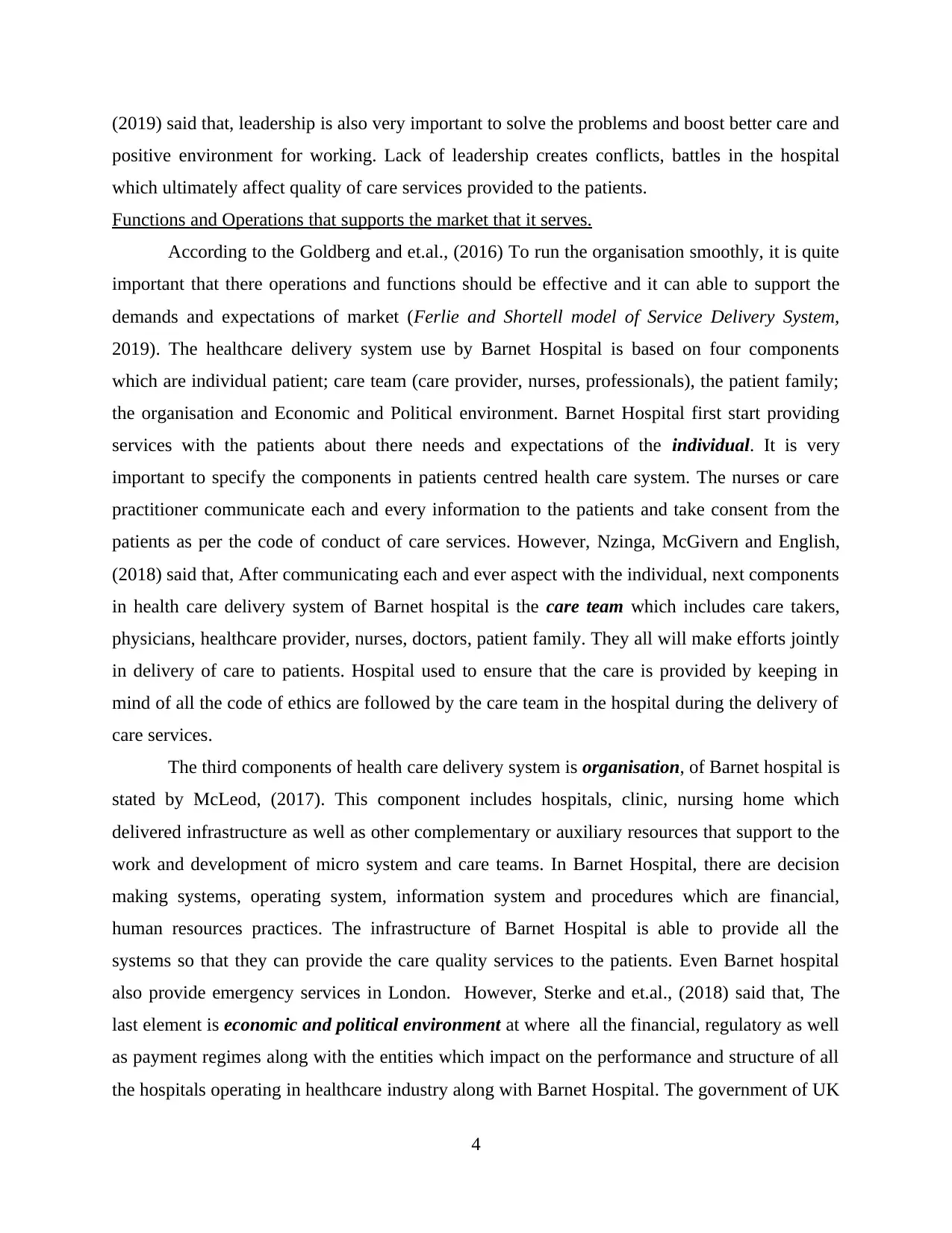
(2019) said that, leadership is also very important to solve the problems and boost better care and
positive environment for working. Lack of leadership creates conflicts, battles in the hospital
which ultimately affect quality of care services provided to the patients.
Functions and Operations that supports the market that it serves.
According to the Goldberg and et.al., (2016) To run the organisation smoothly, it is quite
important that there operations and functions should be effective and it can able to support the
demands and expectations of market (Ferlie and Shortell model of Service Delivery System,
2019). The healthcare delivery system use by Barnet Hospital is based on four components
which are individual patient; care team (care provider, nurses, professionals), the patient family;
the organisation and Economic and Political environment. Barnet Hospital first start providing
services with the patients about there needs and expectations of the individual. It is very
important to specify the components in patients centred health care system. The nurses or care
practitioner communicate each and every information to the patients and take consent from the
patients as per the code of conduct of care services. However, Nzinga, McGivern and English,
(2018) said that, After communicating each and ever aspect with the individual, next components
in health care delivery system of Barnet hospital is the care team which includes care takers,
physicians, healthcare provider, nurses, doctors, patient family. They all will make efforts jointly
in delivery of care to patients. Hospital used to ensure that the care is provided by keeping in
mind of all the code of ethics are followed by the care team in the hospital during the delivery of
care services.
The third components of health care delivery system is organisation, of Barnet hospital is
stated by McLeod, (2017). This component includes hospitals, clinic, nursing home which
delivered infrastructure as well as other complementary or auxiliary resources that support to the
work and development of micro system and care teams. In Barnet Hospital, there are decision
making systems, operating system, information system and procedures which are financial,
human resources practices. The infrastructure of Barnet Hospital is able to provide all the
systems so that they can provide the care quality services to the patients. Even Barnet hospital
also provide emergency services in London. However, Sterke and et.al., (2018) said that, The
last element is economic and political environment at where all the financial, regulatory as well
as payment regimes along with the entities which impact on the performance and structure of all
the hospitals operating in healthcare industry along with Barnet Hospital. The government of UK
4
positive environment for working. Lack of leadership creates conflicts, battles in the hospital
which ultimately affect quality of care services provided to the patients.
Functions and Operations that supports the market that it serves.
According to the Goldberg and et.al., (2016) To run the organisation smoothly, it is quite
important that there operations and functions should be effective and it can able to support the
demands and expectations of market (Ferlie and Shortell model of Service Delivery System,
2019). The healthcare delivery system use by Barnet Hospital is based on four components
which are individual patient; care team (care provider, nurses, professionals), the patient family;
the organisation and Economic and Political environment. Barnet Hospital first start providing
services with the patients about there needs and expectations of the individual. It is very
important to specify the components in patients centred health care system. The nurses or care
practitioner communicate each and every information to the patients and take consent from the
patients as per the code of conduct of care services. However, Nzinga, McGivern and English,
(2018) said that, After communicating each and ever aspect with the individual, next components
in health care delivery system of Barnet hospital is the care team which includes care takers,
physicians, healthcare provider, nurses, doctors, patient family. They all will make efforts jointly
in delivery of care to patients. Hospital used to ensure that the care is provided by keeping in
mind of all the code of ethics are followed by the care team in the hospital during the delivery of
care services.
The third components of health care delivery system is organisation, of Barnet hospital is
stated by McLeod, (2017). This component includes hospitals, clinic, nursing home which
delivered infrastructure as well as other complementary or auxiliary resources that support to the
work and development of micro system and care teams. In Barnet Hospital, there are decision
making systems, operating system, information system and procedures which are financial,
human resources practices. The infrastructure of Barnet Hospital is able to provide all the
systems so that they can provide the care quality services to the patients. Even Barnet hospital
also provide emergency services in London. However, Sterke and et.al., (2018) said that, The
last element is economic and political environment at where all the financial, regulatory as well
as payment regimes along with the entities which impact on the performance and structure of all
the hospitals operating in healthcare industry along with Barnet Hospital. The government of UK
4
⊘ This is a preview!⊘
Do you want full access?
Subscribe today to unlock all pages.

Trusted by 1+ million students worldwide
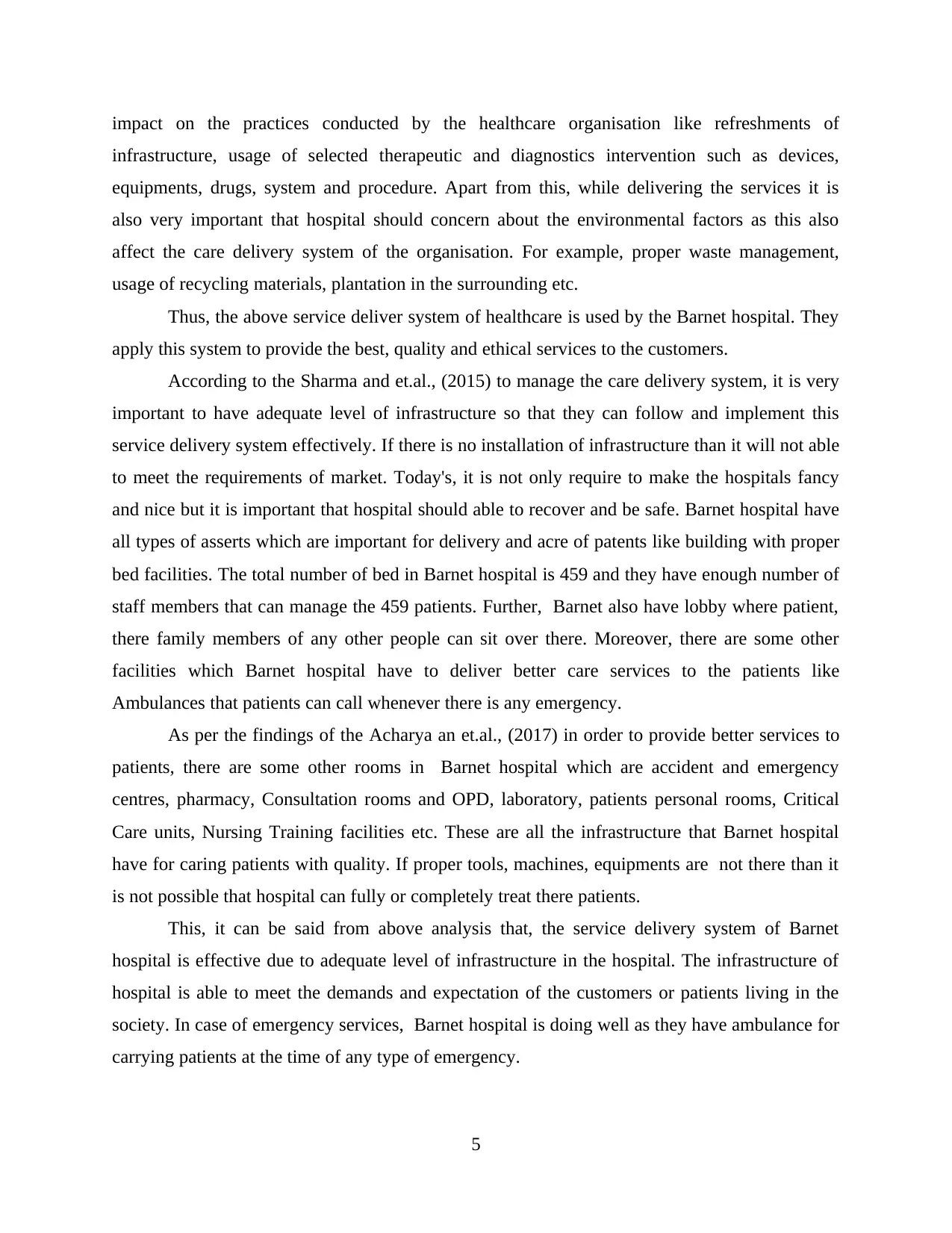
impact on the practices conducted by the healthcare organisation like refreshments of
infrastructure, usage of selected therapeutic and diagnostics intervention such as devices,
equipments, drugs, system and procedure. Apart from this, while delivering the services it is
also very important that hospital should concern about the environmental factors as this also
affect the care delivery system of the organisation. For example, proper waste management,
usage of recycling materials, plantation in the surrounding etc.
Thus, the above service deliver system of healthcare is used by the Barnet hospital. They
apply this system to provide the best, quality and ethical services to the customers.
According to the Sharma and et.al., (2015) to manage the care delivery system, it is very
important to have adequate level of infrastructure so that they can follow and implement this
service delivery system effectively. If there is no installation of infrastructure than it will not able
to meet the requirements of market. Today's, it is not only require to make the hospitals fancy
and nice but it is important that hospital should able to recover and be safe. Barnet hospital have
all types of asserts which are important for delivery and acre of patents like building with proper
bed facilities. The total number of bed in Barnet hospital is 459 and they have enough number of
staff members that can manage the 459 patients. Further, Barnet also have lobby where patient,
there family members of any other people can sit over there. Moreover, there are some other
facilities which Barnet hospital have to deliver better care services to the patients like
Ambulances that patients can call whenever there is any emergency.
As per the findings of the Acharya an et.al., (2017) in order to provide better services to
patients, there are some other rooms in Barnet hospital which are accident and emergency
centres, pharmacy, Consultation rooms and OPD, laboratory, patients personal rooms, Critical
Care units, Nursing Training facilities etc. These are all the infrastructure that Barnet hospital
have for caring patients with quality. If proper tools, machines, equipments are not there than it
is not possible that hospital can fully or completely treat there patients.
This, it can be said from above analysis that, the service delivery system of Barnet
hospital is effective due to adequate level of infrastructure in the hospital. The infrastructure of
hospital is able to meet the demands and expectation of the customers or patients living in the
society. In case of emergency services, Barnet hospital is doing well as they have ambulance for
carrying patients at the time of any type of emergency.
5
infrastructure, usage of selected therapeutic and diagnostics intervention such as devices,
equipments, drugs, system and procedure. Apart from this, while delivering the services it is
also very important that hospital should concern about the environmental factors as this also
affect the care delivery system of the organisation. For example, proper waste management,
usage of recycling materials, plantation in the surrounding etc.
Thus, the above service deliver system of healthcare is used by the Barnet hospital. They
apply this system to provide the best, quality and ethical services to the customers.
According to the Sharma and et.al., (2015) to manage the care delivery system, it is very
important to have adequate level of infrastructure so that they can follow and implement this
service delivery system effectively. If there is no installation of infrastructure than it will not able
to meet the requirements of market. Today's, it is not only require to make the hospitals fancy
and nice but it is important that hospital should able to recover and be safe. Barnet hospital have
all types of asserts which are important for delivery and acre of patents like building with proper
bed facilities. The total number of bed in Barnet hospital is 459 and they have enough number of
staff members that can manage the 459 patients. Further, Barnet also have lobby where patient,
there family members of any other people can sit over there. Moreover, there are some other
facilities which Barnet hospital have to deliver better care services to the patients like
Ambulances that patients can call whenever there is any emergency.
As per the findings of the Acharya an et.al., (2017) in order to provide better services to
patients, there are some other rooms in Barnet hospital which are accident and emergency
centres, pharmacy, Consultation rooms and OPD, laboratory, patients personal rooms, Critical
Care units, Nursing Training facilities etc. These are all the infrastructure that Barnet hospital
have for caring patients with quality. If proper tools, machines, equipments are not there than it
is not possible that hospital can fully or completely treat there patients.
This, it can be said from above analysis that, the service delivery system of Barnet
hospital is effective due to adequate level of infrastructure in the hospital. The infrastructure of
hospital is able to meet the demands and expectation of the customers or patients living in the
society. In case of emergency services, Barnet hospital is doing well as they have ambulance for
carrying patients at the time of any type of emergency.
5
Paraphrase This Document
Need a fresh take? Get an instant paraphrase of this document with our AI Paraphraser
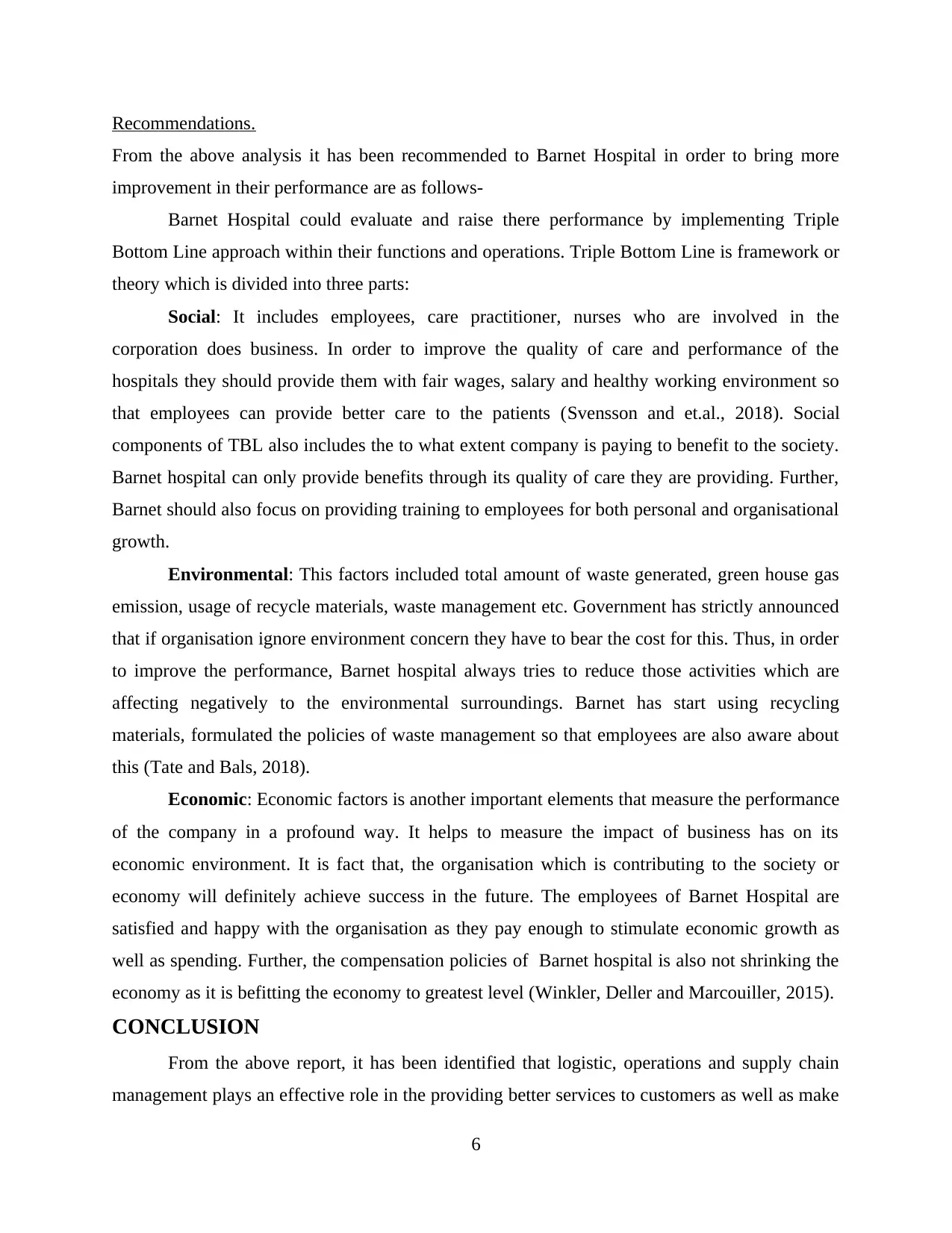
Recommendations.
From the above analysis it has been recommended to Barnet Hospital in order to bring more
improvement in their performance are as follows-
Barnet Hospital could evaluate and raise there performance by implementing Triple
Bottom Line approach within their functions and operations. Triple Bottom Line is framework or
theory which is divided into three parts:
Social: It includes employees, care practitioner, nurses who are involved in the
corporation does business. In order to improve the quality of care and performance of the
hospitals they should provide them with fair wages, salary and healthy working environment so
that employees can provide better care to the patients (Svensson and et.al., 2018). Social
components of TBL also includes the to what extent company is paying to benefit to the society.
Barnet hospital can only provide benefits through its quality of care they are providing. Further,
Barnet should also focus on providing training to employees for both personal and organisational
growth.
Environmental: This factors included total amount of waste generated, green house gas
emission, usage of recycle materials, waste management etc. Government has strictly announced
that if organisation ignore environment concern they have to bear the cost for this. Thus, in order
to improve the performance, Barnet hospital always tries to reduce those activities which are
affecting negatively to the environmental surroundings. Barnet has start using recycling
materials, formulated the policies of waste management so that employees are also aware about
this (Tate and Bals, 2018).
Economic: Economic factors is another important elements that measure the performance
of the company in a profound way. It helps to measure the impact of business has on its
economic environment. It is fact that, the organisation which is contributing to the society or
economy will definitely achieve success in the future. The employees of Barnet Hospital are
satisfied and happy with the organisation as they pay enough to stimulate economic growth as
well as spending. Further, the compensation policies of Barnet hospital is also not shrinking the
economy as it is befitting the economy to greatest level (Winkler, Deller and Marcouiller, 2015).
CONCLUSION
From the above report, it has been identified that logistic, operations and supply chain
management plays an effective role in the providing better services to customers as well as make
6
From the above analysis it has been recommended to Barnet Hospital in order to bring more
improvement in their performance are as follows-
Barnet Hospital could evaluate and raise there performance by implementing Triple
Bottom Line approach within their functions and operations. Triple Bottom Line is framework or
theory which is divided into three parts:
Social: It includes employees, care practitioner, nurses who are involved in the
corporation does business. In order to improve the quality of care and performance of the
hospitals they should provide them with fair wages, salary and healthy working environment so
that employees can provide better care to the patients (Svensson and et.al., 2018). Social
components of TBL also includes the to what extent company is paying to benefit to the society.
Barnet hospital can only provide benefits through its quality of care they are providing. Further,
Barnet should also focus on providing training to employees for both personal and organisational
growth.
Environmental: This factors included total amount of waste generated, green house gas
emission, usage of recycle materials, waste management etc. Government has strictly announced
that if organisation ignore environment concern they have to bear the cost for this. Thus, in order
to improve the performance, Barnet hospital always tries to reduce those activities which are
affecting negatively to the environmental surroundings. Barnet has start using recycling
materials, formulated the policies of waste management so that employees are also aware about
this (Tate and Bals, 2018).
Economic: Economic factors is another important elements that measure the performance
of the company in a profound way. It helps to measure the impact of business has on its
economic environment. It is fact that, the organisation which is contributing to the society or
economy will definitely achieve success in the future. The employees of Barnet Hospital are
satisfied and happy with the organisation as they pay enough to stimulate economic growth as
well as spending. Further, the compensation policies of Barnet hospital is also not shrinking the
economy as it is befitting the economy to greatest level (Winkler, Deller and Marcouiller, 2015).
CONCLUSION
From the above report, it has been identified that logistic, operations and supply chain
management plays an effective role in the providing better services to customers as well as make
6

them satisfied. Coordination and cooperation is very important to have better logistic
management within hospitals. Logistic management helps in organising and managing the
storage inventory in the hospital. Further, it has been analysed that, it is also very important to
have the enough level infrastructure as it helps in providing quality of care services to the
patients. Moreover, triple bottom approach was also discussed which aids in evaluating and
raising there performance of the organisation.
7
management within hospitals. Logistic management helps in organising and managing the
storage inventory in the hospital. Further, it has been analysed that, it is also very important to
have the enough level infrastructure as it helps in providing quality of care services to the
patients. Moreover, triple bottom approach was also discussed which aids in evaluating and
raising there performance of the organisation.
7
⊘ This is a preview!⊘
Do you want full access?
Subscribe today to unlock all pages.

Trusted by 1+ million students worldwide

REFERENCES
Books and Journals:
Acharya, B and et.al., 2017. Partnerships in mental healthcare service delivery in low-resource
settings: developing an innovative network in rural Nepal. Globalization and health. 13(1).
p.2.
Adebanjo, D., Laosirihongthong, T. and Samaranayake, P., 2016. Prioritizing lean supply chain
management initiatives in healthcare service operations: a fuzzy AHP
approach. Production Planning & Control. 27(12). pp.953-966.
Albarune, A.R.B., Farhat, N. and Afzal, F., 2015. Valued supply chain for integrated hospital
management: A conceptual framework. International Journal of Supply Chain
Management. 4(3). pp.39-49.
Benzidia, S., Ageron, B., Bentahar, O. and Husson, J., 2019. Investigating automation and AGV
in healthcare logistics: a case study based approach. International Journal of Logistics
Research and Applications. 22(3). pp.273-293.
Ekeskär, A. and Rudberg, M., 2016. Third-party logistics in construction: the case of a large
hospital project. Construction management and economics. 34(3). pp.174-191.
Fahimnia, B and et.al., 2017. Supply chain design for efficient and effective blood supply in
disasters. International Journal of Production Economics. 183. pp.700-709.
Franco, C. and Alfonso-Lizarazo, E., 2017. A structured review of quantitative models of the
pharmaceutical supply chain. Complexity. 2017.
Gardner, J.W., Linderman, K.W. and McFadden, K.L., 2018. Managing quality crossroads in
healthcare: An integrative supply chain perspective. Quality Management Journal. 25(1).
pp.2-17.
8
Books and Journals:
Acharya, B and et.al., 2017. Partnerships in mental healthcare service delivery in low-resource
settings: developing an innovative network in rural Nepal. Globalization and health. 13(1).
p.2.
Adebanjo, D., Laosirihongthong, T. and Samaranayake, P., 2016. Prioritizing lean supply chain
management initiatives in healthcare service operations: a fuzzy AHP
approach. Production Planning & Control. 27(12). pp.953-966.
Albarune, A.R.B., Farhat, N. and Afzal, F., 2015. Valued supply chain for integrated hospital
management: A conceptual framework. International Journal of Supply Chain
Management. 4(3). pp.39-49.
Benzidia, S., Ageron, B., Bentahar, O. and Husson, J., 2019. Investigating automation and AGV
in healthcare logistics: a case study based approach. International Journal of Logistics
Research and Applications. 22(3). pp.273-293.
Ekeskär, A. and Rudberg, M., 2016. Third-party logistics in construction: the case of a large
hospital project. Construction management and economics. 34(3). pp.174-191.
Fahimnia, B and et.al., 2017. Supply chain design for efficient and effective blood supply in
disasters. International Journal of Production Economics. 183. pp.700-709.
Franco, C. and Alfonso-Lizarazo, E., 2017. A structured review of quantitative models of the
pharmaceutical supply chain. Complexity. 2017.
Gardner, J.W., Linderman, K.W. and McFadden, K.L., 2018. Managing quality crossroads in
healthcare: An integrative supply chain perspective. Quality Management Journal. 25(1).
pp.2-17.
8
Paraphrase This Document
Need a fresh take? Get an instant paraphrase of this document with our AI Paraphraser

Goldberg, S.B and et.al., 2016. Creating a climate for therapist improvement: A case study of an
agency focused on outcomes and deliberate practice. Psychotherapy. 53(3). p.367.
Gundlach, G.T., Frankel, R. and Krotz, R.T., 2019. Competition policy and antitrust law:
implications of developments in supply chain management. Journal of Supply Chain
Management. 55(2). pp.47-67.
Law, K.M., 2016. How schedule issues affect drug logistics operations: an empirical study in
hospitals in China. Industrial Management & Data Systems. 116(3). pp.369-387.
Mathur, B and et.al., 2018. Healthcare supply chain management: literature review and some
issues. Journal of Advances in Management Research. 15(3). pp.265-287.
McLeod, H., 2017. A review of the evidence on organisational development in
healthcare. Organisational Development in Healthcare: Approaches, Innovations,
Achievements. p.173.
Moons, K., Waeyenbergh, G. and Pintelon, L., 2019. Measuring the logistics performance of
internal hospital supply chains–a literature study. Omega. 82. pp.205-217.
Nyaga, G.N., Young, G.J. and Zepeda, E.D., 2015. An analysis of the effects of intra‐and
interorganizational arrangements on hospital supply chain efficiency. Journal of Business
logistics. 36(4). pp.340-354.
Nzinga, J., McGivern, G. and English, M., 2018. Examining clinical leadership in Kenyan public
hospitals through the distributed leadership lens. Health policy and planning. 33(suppl_2),
pp.ii27-ii34.
Sharma, S and et.al., 2015. Point-of-care diagnostics in low resource settings: present status and
future role of microfluidics. Biosensors. 5(3). pp.577-601.
9
agency focused on outcomes and deliberate practice. Psychotherapy. 53(3). p.367.
Gundlach, G.T., Frankel, R. and Krotz, R.T., 2019. Competition policy and antitrust law:
implications of developments in supply chain management. Journal of Supply Chain
Management. 55(2). pp.47-67.
Law, K.M., 2016. How schedule issues affect drug logistics operations: an empirical study in
hospitals in China. Industrial Management & Data Systems. 116(3). pp.369-387.
Mathur, B and et.al., 2018. Healthcare supply chain management: literature review and some
issues. Journal of Advances in Management Research. 15(3). pp.265-287.
McLeod, H., 2017. A review of the evidence on organisational development in
healthcare. Organisational Development in Healthcare: Approaches, Innovations,
Achievements. p.173.
Moons, K., Waeyenbergh, G. and Pintelon, L., 2019. Measuring the logistics performance of
internal hospital supply chains–a literature study. Omega. 82. pp.205-217.
Nyaga, G.N., Young, G.J. and Zepeda, E.D., 2015. An analysis of the effects of intra‐and
interorganizational arrangements on hospital supply chain efficiency. Journal of Business
logistics. 36(4). pp.340-354.
Nzinga, J., McGivern, G. and English, M., 2018. Examining clinical leadership in Kenyan public
hospitals through the distributed leadership lens. Health policy and planning. 33(suppl_2),
pp.ii27-ii34.
Sharma, S and et.al., 2015. Point-of-care diagnostics in low resource settings: present status and
future role of microfluidics. Biosensors. 5(3). pp.577-601.
9
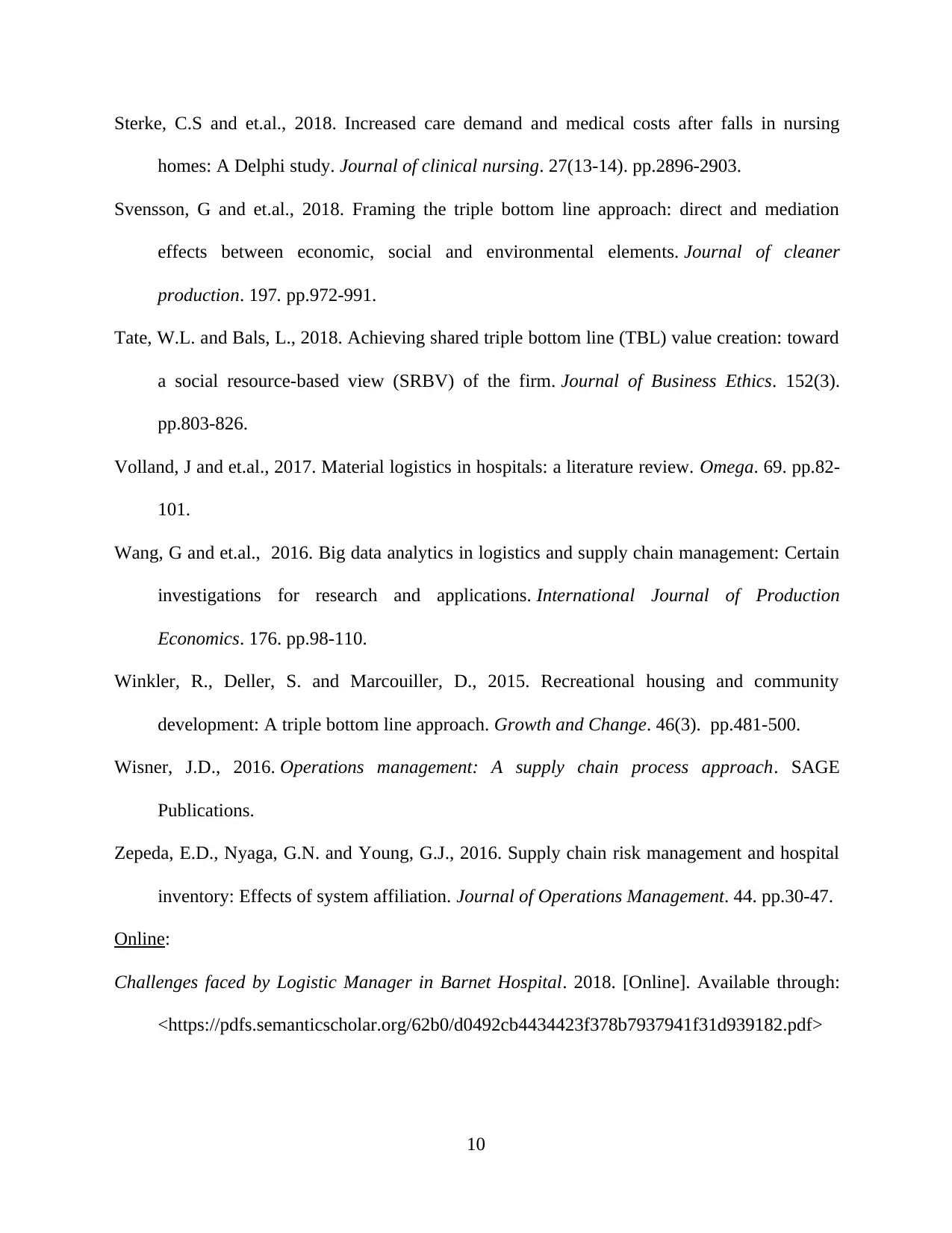
Sterke, C.S and et.al., 2018. Increased care demand and medical costs after falls in nursing
homes: A Delphi study. Journal of clinical nursing. 27(13-14). pp.2896-2903.
Svensson, G and et.al., 2018. Framing the triple bottom line approach: direct and mediation
effects between economic, social and environmental elements. Journal of cleaner
production. 197. pp.972-991.
Tate, W.L. and Bals, L., 2018. Achieving shared triple bottom line (TBL) value creation: toward
a social resource-based view (SRBV) of the firm. Journal of Business Ethics. 152(3).
pp.803-826.
Volland, J and et.al., 2017. Material logistics in hospitals: a literature review. Omega. 69. pp.82-
101.
Wang, G and et.al., 2016. Big data analytics in logistics and supply chain management: Certain
investigations for research and applications. International Journal of Production
Economics. 176. pp.98-110.
Winkler, R., Deller, S. and Marcouiller, D., 2015. Recreational housing and community
development: A triple bottom line approach. Growth and Change. 46(3). pp.481-500.
Wisner, J.D., 2016. Operations management: A supply chain process approach. SAGE
Publications.
Zepeda, E.D., Nyaga, G.N. and Young, G.J., 2016. Supply chain risk management and hospital
inventory: Effects of system affiliation. Journal of Operations Management. 44. pp.30-47.
Online:
Challenges faced by Logistic Manager in Barnet Hospital. 2018. [Online]. Available through:
<https://pdfs.semanticscholar.org/62b0/d0492cb4434423f378b7937941f31d939182.pdf>
10
homes: A Delphi study. Journal of clinical nursing. 27(13-14). pp.2896-2903.
Svensson, G and et.al., 2018. Framing the triple bottom line approach: direct and mediation
effects between economic, social and environmental elements. Journal of cleaner
production. 197. pp.972-991.
Tate, W.L. and Bals, L., 2018. Achieving shared triple bottom line (TBL) value creation: toward
a social resource-based view (SRBV) of the firm. Journal of Business Ethics. 152(3).
pp.803-826.
Volland, J and et.al., 2017. Material logistics in hospitals: a literature review. Omega. 69. pp.82-
101.
Wang, G and et.al., 2016. Big data analytics in logistics and supply chain management: Certain
investigations for research and applications. International Journal of Production
Economics. 176. pp.98-110.
Winkler, R., Deller, S. and Marcouiller, D., 2015. Recreational housing and community
development: A triple bottom line approach. Growth and Change. 46(3). pp.481-500.
Wisner, J.D., 2016. Operations management: A supply chain process approach. SAGE
Publications.
Zepeda, E.D., Nyaga, G.N. and Young, G.J., 2016. Supply chain risk management and hospital
inventory: Effects of system affiliation. Journal of Operations Management. 44. pp.30-47.
Online:
Challenges faced by Logistic Manager in Barnet Hospital. 2018. [Online]. Available through:
<https://pdfs.semanticscholar.org/62b0/d0492cb4434423f378b7937941f31d939182.pdf>
10
⊘ This is a preview!⊘
Do you want full access?
Subscribe today to unlock all pages.

Trusted by 1+ million students worldwide
1 out of 13
Related Documents
Your All-in-One AI-Powered Toolkit for Academic Success.
+13062052269
info@desklib.com
Available 24*7 on WhatsApp / Email
![[object Object]](/_next/static/media/star-bottom.7253800d.svg)
Unlock your academic potential
Copyright © 2020–2025 A2Z Services. All Rights Reserved. Developed and managed by ZUCOL.




